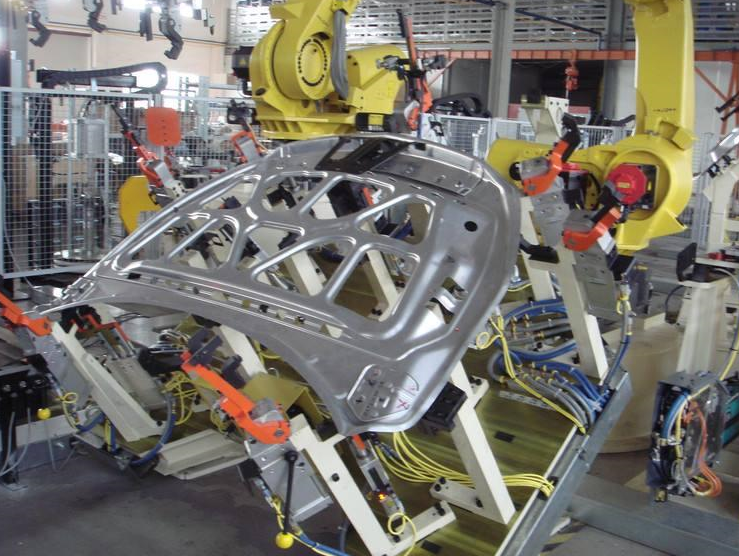
Speaking of automobile laser welding, it can be traced back to the 1980s, when it was mainly welding the body. In the past 40 years, today's laser welding production line has appeared in the automobile manufacturing industry on a large scale, and has become one of the outstanding achievements of the automobile manufacturing industry.
The application of laser welding technology in the automobile industry began in Germany. In the 1980s, European automobile manufacturers such as Audi, Mercedes Benz, Volkswagen and Volvo in Sweden took the lead in using laser welding for sheet metal welding such as roof, body and side frame. In the 1990s, American general motors, Ford and Chrysler competed to introduce laser welding into automobile manufacturing. Although it started late, it developed rapidly. Subsequently, Fiat of Italy adopted laser welding in the welding and assembly of most steel plate components, and Nissan, Honda and Toyota of Japan also used laser welding process in the manufacture of body panels. Since then, high-strength steel laser welding assemblies have been used more and more in the manufacture of automobile bodies because of their excellent performance.
The booming automobile market drives the development of laser welding industry
With the transformation and upgrading of China's manufacturing industry, the requirements of many industries for product welding quality are constantly improving. Under this background, the application popularization rate of laser welding in many industries is increasing, especially the processing and manufacturing of metal materials and parts. Its penetration rate is at a high level. At present, the automotive industry is an important application market of laser welding in China.
Both the medium and long term development plan of automobile industry and the development plan of new energy automobile industry (2021-2035) issued in the early stage release an important signal: electric vehicle is a national established industrial strategy, and the direction of promoting its sustainable and healthy development at the policy level will not be shaken. These policies are promoting healthy and orderly development from multiple dimensions and will benefit the development of new energy vehicle industry in the long term.
In 2015, China became the largest country in the sales of new energy vehicles. In the past six years, the sales of new energy vehicles in China has always maintained a steady upward trend. With the rapid development of domestic new energy vehicle production and lithium battery industry. According to the statistics of China Automobile Association, in the first half of 2021, the sales volume of new energy vehicles in China exceeded 1.2 million, and the power battery loading volume accumulated 52.5gwh. The cumulative sales volume has been in line with the annual level in 2019, and the emerging kinetic energy is continuously expanding.
At present, the electrification of the global automobile industry is accelerating. Governments of various countries provide policy support such as consumer car purchase subsidies, which stimulates the continuous rise of global new energy vehicle sales performance. The global research department of Bank of America predicts that from 2025 to 2040, the global penetration rate of all electric vehicles in the world, including pure electric vehicles (BEVS) and plug-in hybrid vehicles (PHEVs), will rise from 23% to 67%.
SNE research, a global emerging energy market research organization, predicts that the global sales of new energy vehicles is expected to reach 15 million in 2025, 23 million in 2030, and the market capacity is expected to increase by more than ten times. A strong new energy vehicle market will accelerate the development of laser welding industry.
Application of laser welding technology in automobile parts
A car is assembled from about 20000 parts, of which iron parts account for the vast majority. Although they are collectively referred to as iron, the frame constituting the body frame and the body part shaping the model use steel plates, transmissions and other box parts, and the box part uses castings made by melting iron and injecting it into the mold. Therefore, the welding process is an indispensable process in the process of automobile production and processing, such as frame, body, carriage, engine, automobile gear, roof, door, automobile seat sliding parts, automobile airbag liner, exhaust pipe, automobile clutch, etc.
Compared with traditional resistance welding, carbon dioxide gas shielded welding and other traditional welding technologies, laser welding technology has superior effect in new alloy materials. It has the advantages of fast welding speed, good quality, high production efficiency, large weld depth width ratio, bright and beautiful, small heat input, small welding heat affected zone and not easy to deform, so it has good performance in automobile parts processing, such as efficiency, economy, safety, strength and high corrosion, and can realize butt welding, overlap welding, body welding and parts welding of automobile parts, Effectively reduce the body weight, improve the body assembly accuracy, increase the body strength, and reduce the stamping and assembly cost in the process of automobile body manufacturing.
Relying on its exploration in the field of laser welding, Lianying laser has applied advanced laser flight welding, laser wire filling welding, woble welding, multi wavelength blue light composite welding technology and multi wavelength blue light swing composite welding technology to automobile engine exhaust manifold, cylinder gasket, high-pressure manifold, oxygen sensor, gearbox fork, half shell assembly, automobile steering system steering support, guide tube Among many automobile parts such as steering wheel assembly, through the perfect combination with modern automobile manufacturing, it will provide more high-quality solutions for the future development of automobile lightness.
